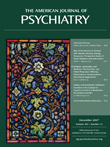Withdrawal of Attention Rather Than Pharmacological Treatment Affects Suicide Rates in Depressed Children and Adolescents
To The Editor: Dr. Gibbons et al. concluded that regulators’ suicidality warning on SSRI prescriptions to children and adolescents has caused a decrease in the use of antidepressants and subsequent increase in suicide rates among this age group.
However, instead of being due to the withdrawal of medication (i.e., SSRIs), the increase in suicidality may result from the withdrawal of attention that was previously provided in the context of pharmacological treatment. With pharmacological possibilities being restricted, patients are not only getting fewer pills but are receiving altogether less professional attention and care, contributing in turn to an increased suicide rate.
The plausibility of this alternative explanation is supported by two pieces of evidence. First, a decline in attention to pediatric patients with depression was reported by Libby et al. (1) . In addition to a decrease in the number of patients receiving the diagnosis of depression, those diagnosed with depression received pharmacological treatment less frequently, while no alternative treatments were offered. Second, a favorable effect of placebo (i.e., attention) on suicidality was suggested when attempted suicide rates among young adults in a Veterans Health Administration (VA) study (2) were compared with rates from the FDA meta-analysis. Suicide rates among treated patients in the FDA and VA studies were remarkably similar (551 and 447 per 100,000, respectively), while rates in the placebo-treated groups in the FDA analysis were considerably lower than those of the untreated group in the VA study (447 versus 1,368 per 100,000). Attributing this difference to the recruitment of nonsuicidal patients to clinical trials is not very likely, given the similar suicide rates of the treated groups. The difference is more likely the result of the favorable effect of placebo among patients in clinical trials, from which the untreated VA patients could not benefit.
The warning issued with respect to the use of SSRIs has apparently not only led to a more cautious and judicial use of medication (as was intended), but also to a reduction in attention that was previously provided in the context of pharmacological treatment. It is the latter effect that may be responsible for the increase in suicidality and should be ideally reversed. It seems therefore necessary to clarify to treatment providers and treatment seekers that caution in prescribing SSRIs does not imply withdrawal of other forms of providing attention to depressed patients.
1. Libby AM, Brent DA, Morrato EH, Orton HD, Allen R, Valuck RJ: Decline in treatment of pediatric depression after FDA advisory on risk of suicidality with SSRIs. Am J Psychiatry 2007; 164:884–891Google Scholar
2. Gibbons RD, Brown CH, Hur K, Marcus SM, Bhaumik DK, Mann JJ: Relationship between antidepressants and suicide attempts: an analysis of the Veterans Health Administration data sets. Am J Psychiatry 2007; 164:1044–1049Google Scholar



